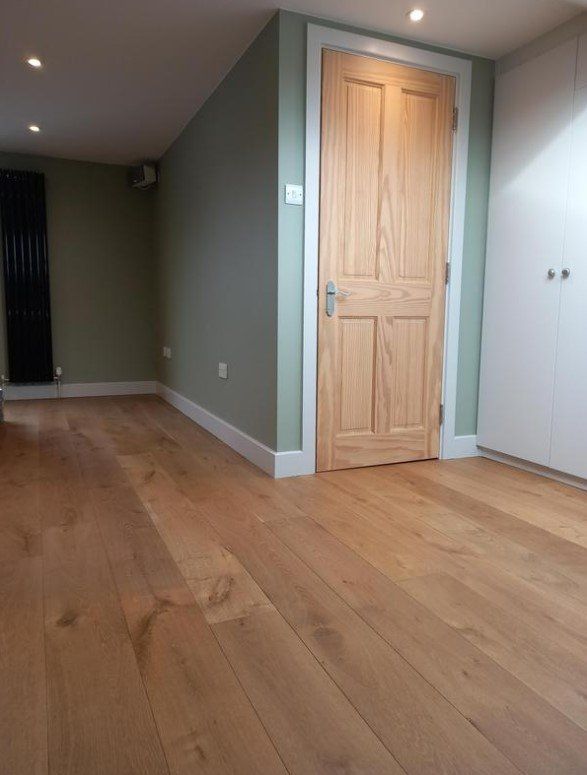When it comes to transforming the appearance of a space quickly and affordably, Painters and Decorators Liverpool acknowledge painting your walls with a fresh coat of paint is the way to go. Julia Marcum, a product designer and DIY home blogger, attests to the transformative powers of paint, stating that it has the ability to make a plain room appear more upscale and even brighten up less desirable features such as worn-out floors.
In most instances, painting a room in your home is a project that you can take on yourself, unless you're dealing with particularly challenging areas like steep staircases or exceptionally high ceilings. However, before you embark on your painting project, it's essential to familiarise yourself with the best practices for preparing your space, selecting the appropriate tools, and executing a professional-level application. To help you navigate this process seamlessly, our painters and decorators in Liverpool have developed a step-by-step guide. By following these guidelines, you can ensure a successful painting project from start to finish.
Select the Perfect Paint Colour
Navigating the vast array of paint colors offered at paint or DIY stores can be overwhelming. To determine the ideal color for your space, it is essential to observe how it appears under your room's lighting conditions, both natural and artificial, throughout the day.
consider purchasing sample-size paint pots and applying the shades to a white poster board that can be hung up, or opt for peel-and-stick swatches. It is worth noting that directly painting the samples onto your wall may alter the true appearance of the colors, especially if your wall is not a basic white.
Select the Perfect Finish for your Paint Colour
After finalizing your color choice, another important decision awaits: selecting the appropriate finish for your paint. The finish significantly influences the paint's glossiness and durability once it dries. Paints typically offer a range of options, with varying levels of reflectiveness, spanning from matte to high gloss. It's essential to note that shinier finishes tend to highlight any imperfections on the walls, so smoother surfaces are more suitable for such finishes.
Eggshell, a step up from flat, is a popular selection for walls in non-damp areas like living rooms and bedrooms. It strikes a balance between being glossy enough for easy scrubbing and matte enough to conceal minor flaws. When it comes to painting trim in these areas, it is advisable to opt for a satin or semi-gloss finish for enhanced durability and to create a contrasting effect.
In bathrooms and kitchens, where moisture is a factor, it is generally recommended to use at least a satin finish for the walls. This choice facilitates effortless cleaning and provides better resistance against moisture-related issues. Satin or glossier finishes can also be used for the trim in these areas.
When it comes to ceilings, which are less prone to fingerprints and wear, matt paint is often the go-to option. Matt finishes are typically the most resilient when it comes to scrubbing clean. Additionally, using matt paint on ceilings ensures that excessive light reflection is avoided, allowing the focus to remain on the rest of the room's elements.
Determine the amount of primer and paint required
To accurately determine the amount of paint required for the room you plan to paint, utilising a paint calculator can be highly beneficial. B&Q offers a reliable paint calculator that can assist you in this task. It's important to remember that it is generally recommended to have enough paint for two coats.
Consider the existing shade on the walls, as this may necessitate the use of a primer. Our painters and decorators in Liverpool suggest having the paint suppliers tint the primer gray when undergoing a significant color change. This approach effectively conceals the previous color and aids in the blocking process.
A primer serves as a foundational coat that promotes adhesion of the topcoat while also blocking stains, imperfections, and mold. Although not always obligatory, a primer is particularly useful when transitioning from a light color to a dark one or when opting for a paint that already incorporates a built-in primer. Using a primer ensures a smoother application overall.
In instances where you are transforming a room from a dark hue to a lighter one, such as transitioning from royal blue to baby pink, a separate coat of primer is definitely necessary.
Additionally, if your walls are freshly plastered, modern paint may not adhere well to them. In such cases, starting with a primer is highly recommended.
Protect yourself
Prior to painting your walls and engaging in the sanding process, it is crucial to prioritize safety measures that shield you from potentially harmful particles. To achieve this, it is highly recommended to wear safety goggles along with a face mask or respirator. This is particularly important if your house predates 1978, as it may contain remnants of lead-based paint.
Even though modern paint formulations generally have low levels of volatile organic compounds (VOCs), it is still advisable to protect your respiratory system and eyes by utilizing appropriate face and eye protection during the painting process. If feasible, it is also beneficial to open a window and maintain a slight opening until the paint has completely dried, which typically takes approximately one day. By adhering to these safety precautions, you can ensure the well-being of both your respiratory health and visual acuity.
Prepare your surfaces
Similar to the process of cleansing your face before applying makeup, preparing your walls is essential before initiating the painting process. According to Patrick O'Donnell, Farrow & Ball's international brand ambassador and color consultant, it is crucial to eliminate grease, oil, and dust by sanding and washing down your walls. Although this step may not be the most exciting, it is undoubtedly necessary.
To begin, thoroughly clean your walls (and ceiling if it is part of the painting project) using a mixture of warm water and dish detergent. Using a cellulose sponge, gently wipe the solution onto the surfaces using a circular motion. Once the walls have dried, proceed to fill any holes or cracks by applying joint compound with the assistance of a putty knife.
Next, carefully sand the surfaces using 220-grit sandpaper. This can be done manually or with the help of a sanding pole, as electric hand-sanders tend to be too aggressive for this purpose. In case you need to smoothen trim or molding, a sanding sponge designed for reaching tight spaces can be a useful tool.
Lastly, take precautionary measures by removing light switch and outlet covers, rolling up rugs, and relocating furniture to the center of the room. To protect items from potential sprinkles or spatters, cover them with a drop cloth or plastic sheeting. Shannon Duvall, co-owner of HD Paint and Stain, a house painting company in Belleville, Illinois, emphasizes the importance of this step. By diligently following these instructions, you can ensure a well-prepared surface and a protected environment for your painting endeavors.
Tape
To achieve clean and professional-looking lines while preventing paint from bleeding into unwanted areas, painters' tape can prove to be an invaluable tool.
For optimal results, Shannon Duvall, co-owner of HD Paint and Stain, recommends using a tape with "edge lock" feature that effectively minimizes leakage. Begin by taping off the section adjacent to the area you intend to paint. For instance, tape along the trim and ceiling before painting the walls, and tape along the edges of the walls prior to painting the trim or ceiling.
When applying the tape, work in increments of about six inches, as this makes it easier to maintain a straight line. Press down firmly as you progress, and ensure a secure seal by running a putty knife or a damp cloth along the length of the tape. It is generally advised to let the tape "set" for 30 to 90 minutes, as recommended by most manufacturers, to allow it to adhere fully.
While some experts argue that using the correct paint brush and technique can eliminate the need for taping, it is considered the most reliable approach for those new to painting. Marcum suggests that a high-quality, two-inch, short-handled paint brush can render taping unnecessary. However, for beginners, taping remains the surest method to achieve a neat and well-defined paint job.
Use the Correct Tools
A combination of rolling and brushing is commonly recommended by painters to achieve optimal results when applying paint. The recommended sequence involves starting with the ceiling, followed by the walls, and concluding with the trim.
To begin, you will need a paint key (usually available for free at most paint stores) or a putty knife to open the paint can. It is advisable to stir the paint using a chopstick or stirring stick (another item often provided for free by paint stores) to ensure thorough blending of all the pigments.
The initial step is "cutting in," which entails carefully applying a straight line of paint along the edge of the wall where it meets the molding, trim, or floor. It is also necessary to cut in around areas such as light switches, door and window frames, and other narrow spots. Shannon Duvall suggests dipping the brush about halfway into the paint, and tapping off any excess before gently but firmly applying it to the wall. She also recommends using a two- to four-inch angled brush for this process
Subsequently, proceed to cover the majority of the walls and ceiling using a roller. Experts commonly recommend a nine-inch roller with a nap measuring half to one inch. Pour the paint into a roller tray, preerably an environmentally friendly reusable one, and coat the roller with paint through short, rapid dips.
While the brushed edges are still wet, roll the paint onto the walls using a tight "W" pattern to ensure comprehensive coverage. It is advised to start with vertical strokes and then proceed horizontally to achieve complete coverage. Allow the paint to dry between coats, which typically takes two to four hours. However, it is important to consult the recommendations provided on the paint can for specific drying times.
For painting the trim, employ a two-inch angled brush and utilise long, single strokes. According to Duvall, minimising brush marks is crucial since shinier trim paint tends to reveal imperfections more prominently. By following these guidelines, you can effectively navigate the process of painting various surfaces to achieve a polished and professional finish.
Remove tape and clean up
After applying the final coat of paint, it is important to follow the proper procedure for removing the blue painters' tape to avoid any unwanted damage. Allow the paint to partially dry, typically for about two to four hours, before beginning the tape removal process. Carefully pull the tape at a 45-degree angle, exerting gentle and slow pressure. It is crucial to note that if you wait until the paint has completely dried, there is a higher likelihood of inadvertently peeling off some of the paint along with the tape.
In the case of using emulsion paint, it is recommended to clean the brushes and rollers promptly to ensure their optimal condition for future projects. This can be achieved by washing them with soap and warm water. Brush combs and a rag can prove useful in removing any excess paint before cleaning. On the other hand, if oil-based paints and primer were used, it is necessary to clean the brushes and rollers with a suitable solvent. Look for specific recommendations on the paint can regarding the appropriate cleaning method for oil-based products.
By adhering to these instructions, you can ensure a smooth and successful tape removal process and maintain the longevity of your painting tools for future endeavors.
For expert guidance and assistance with your upcoming painting and decorating project, consider contacting Painters and Decorators Liverpool. Our team of professionals can provide valuable advice tailored to your specific needs. Whether you require assistance with choosing the right color scheme, selecting suitable materials, or executing the painting and decorating process, our expertise can be instrumental in achieving your desired results.
If you would like to explore more information about house painting, you can visit their dedicated page on
domestic painting and decorating services


